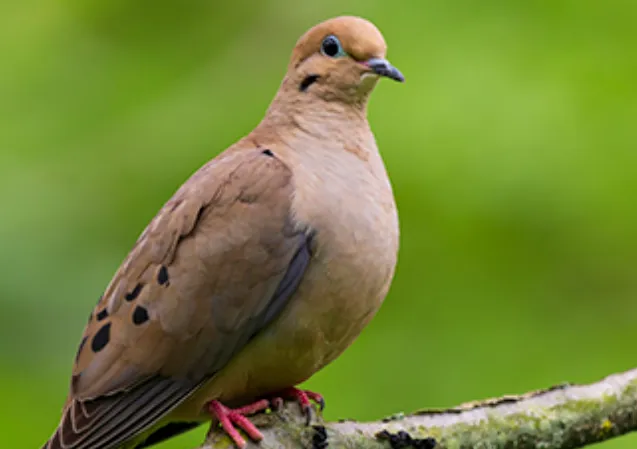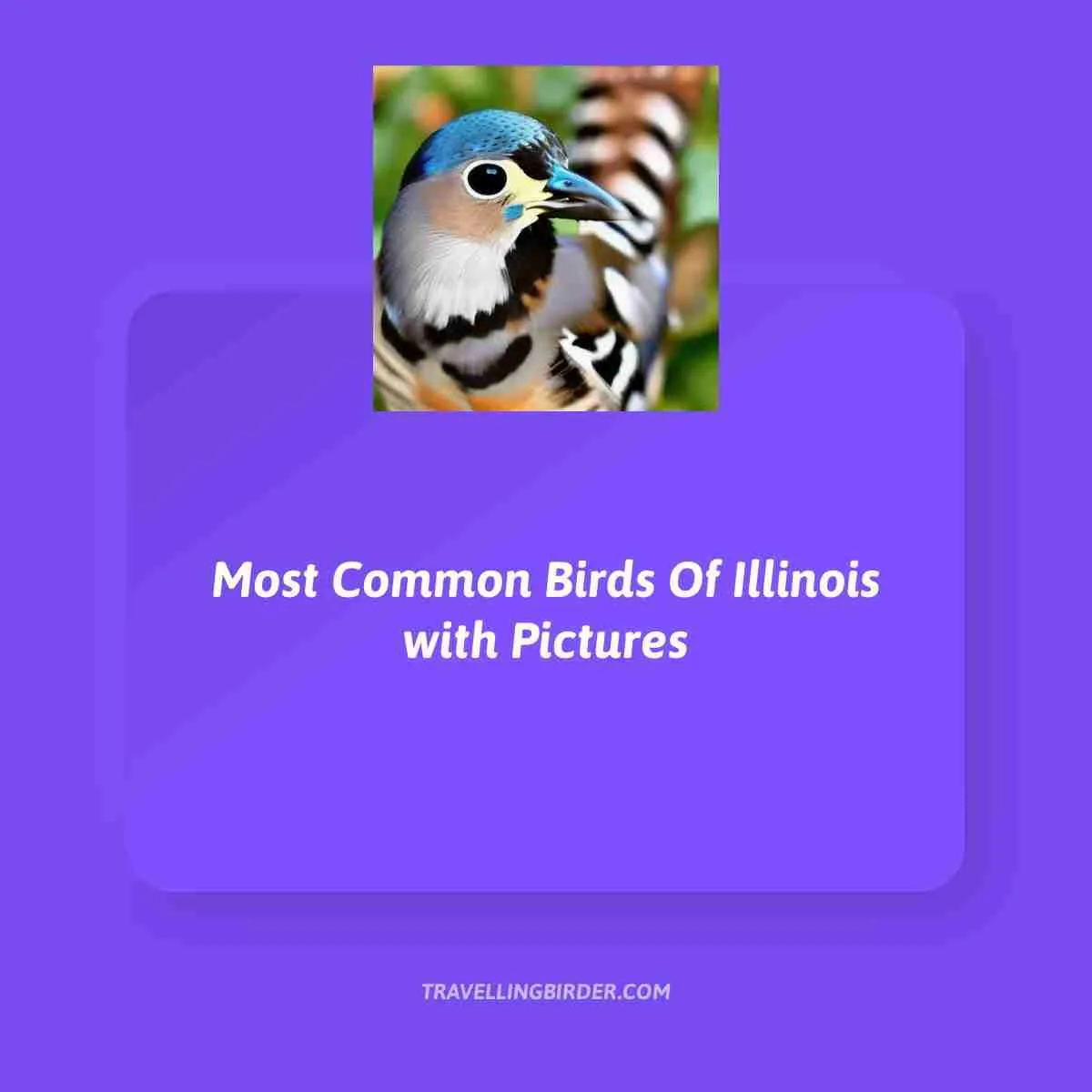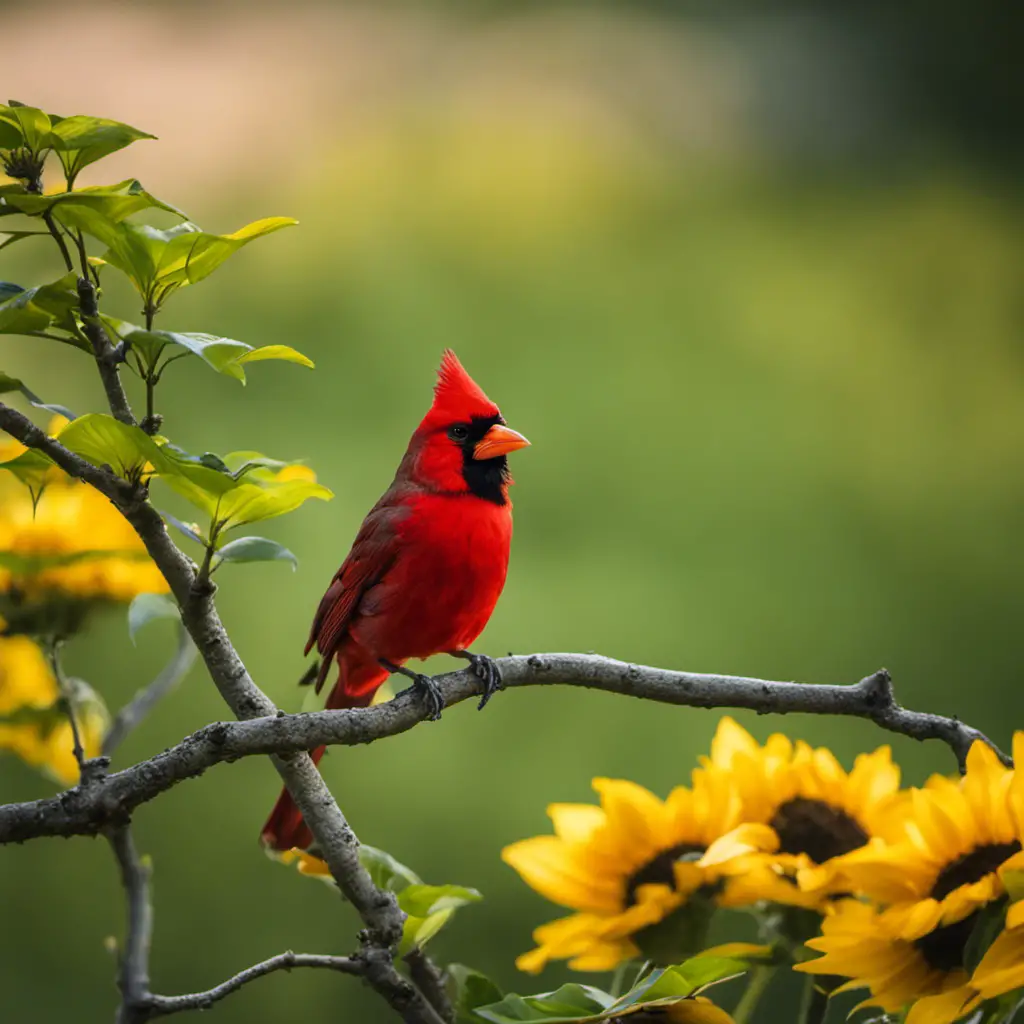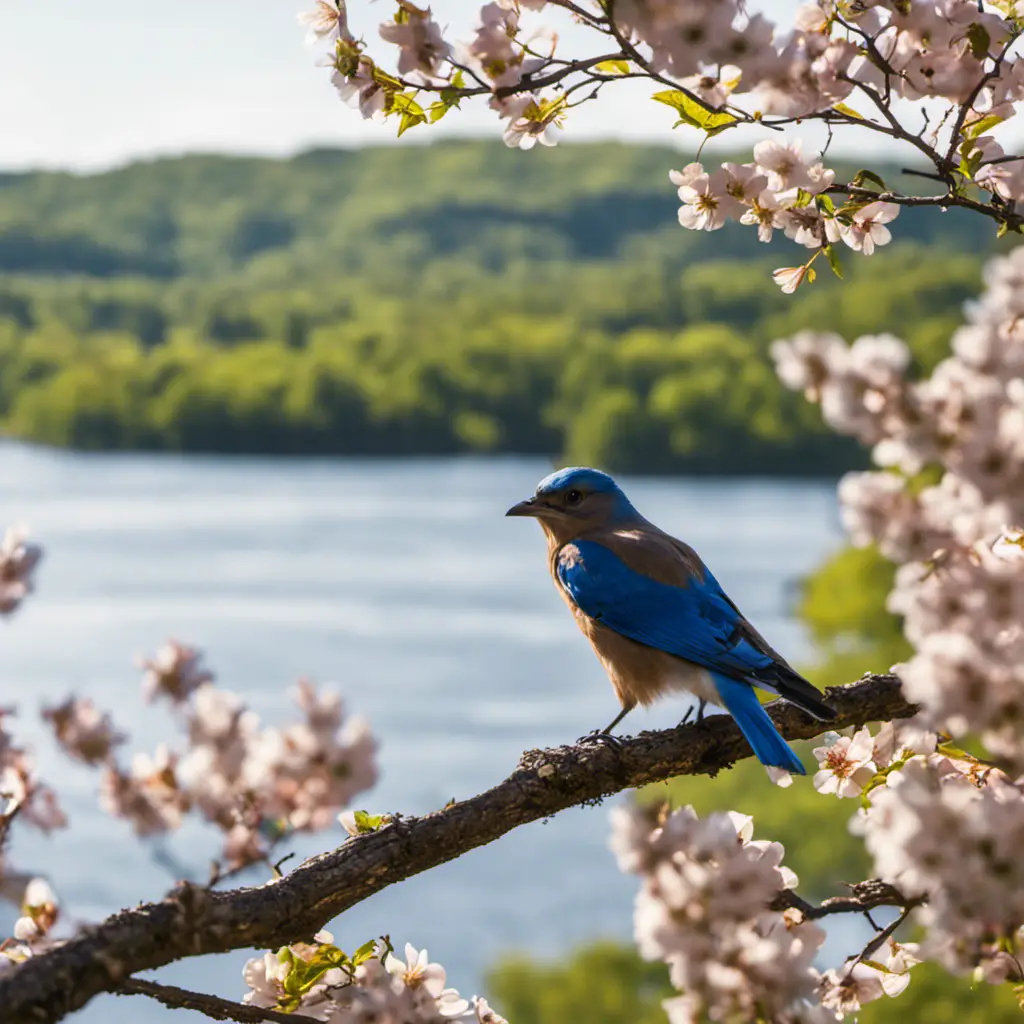You’ll learn all about the diverse avian species that call Minnesota home in this fascinating article.
From the graceful Common Loon to the majestic Bald Eagle, these birds captivate with their unique characteristics.
Discover the intricate flight patterns of the Ruby-throated Hummingbird and the striking appearance of the Red-tailed Hawk.
Explore the habitats and behaviors of these birds as we delve into the rich ornithological tapestry that exists in Minnesota.
Get ready for an enlightening journey through the Birds of Minnesota.
Key Takeaways
- Minnesota is home to a diverse range of bird species, including water birds, birds of prey, songbirds, migratory birds, and urban birds.
- Some notable water birds found in Minnesota include the American Coot, Common Loon, Double-crested Cormorant, and Canada Goose.
- The state is also home to impressive birds of prey, such as the Bald Eagle, Great Horned Owl, and Red-tailed Hawk.
- Minnesota’s songbird population includes species like the American Crow, Eastern Bluebird, Eastern Kingbird, Eastern Phoebe, Hairy Woodpecker, House Finch, House Sparrow, Northern Cardinal, Northern Flicker, Northern Mockingbird, and Red-bellied Woodpecker.
American coot
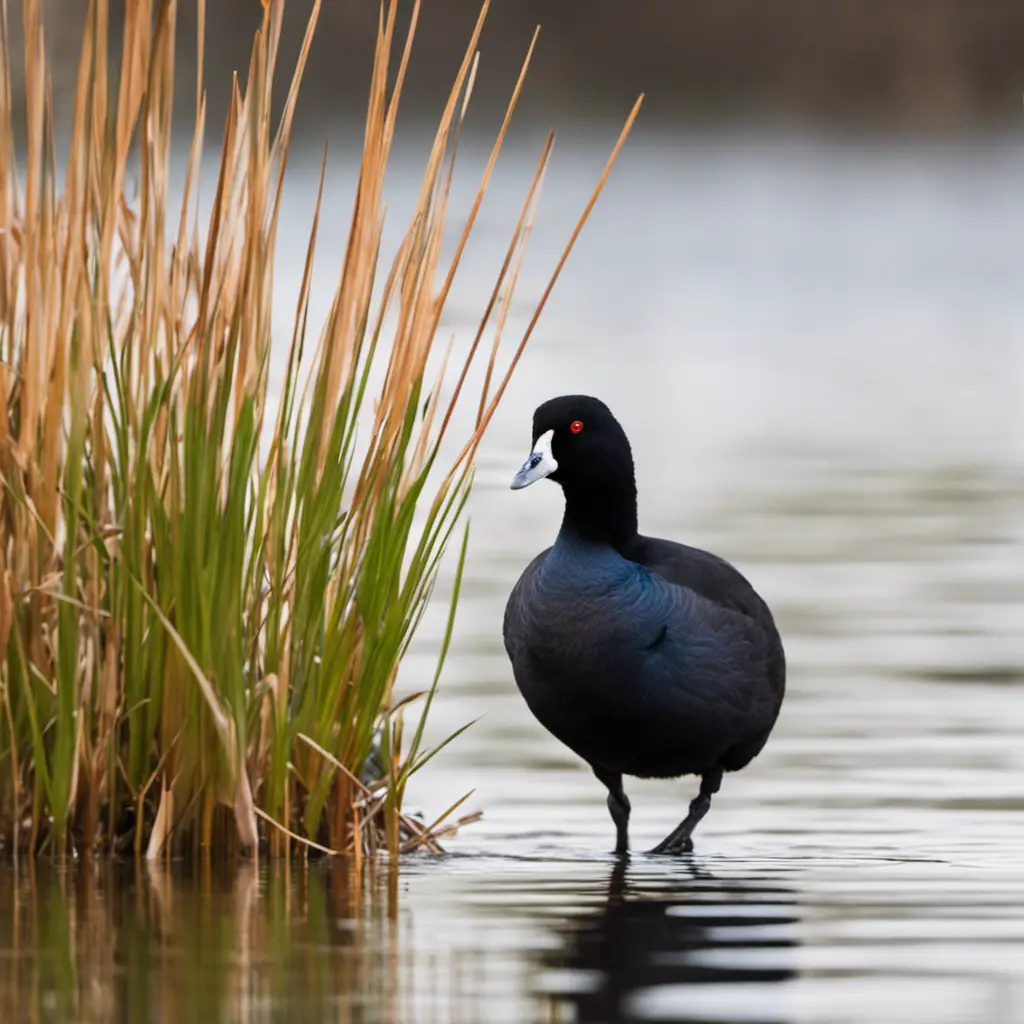
You should observe the American coot closely as it swims gracefully in the lake. This unique waterbird can be found in various habitats across Minnesota, including marshes, ponds, and lakes.
The American coot is well adapted to both freshwater and brackish water environments. It prefers areas with abundant vegetation, as it feeds on aquatic plants, insects, and small fish.
During the breeding season, you may witness interesting behaviors displayed by these birds. Male coots engage in elaborate courtship displays, including head-bobbing, wing-flapping, and vocalizations. They also build floating nests made of vegetation, often hidden among the reeds or cattails.
The female lays a clutch of 6-12 eggs, which both parents incubate. Once hatched, the chicks are precocial and able to swim and feed themselves shortly after birth.
American crow
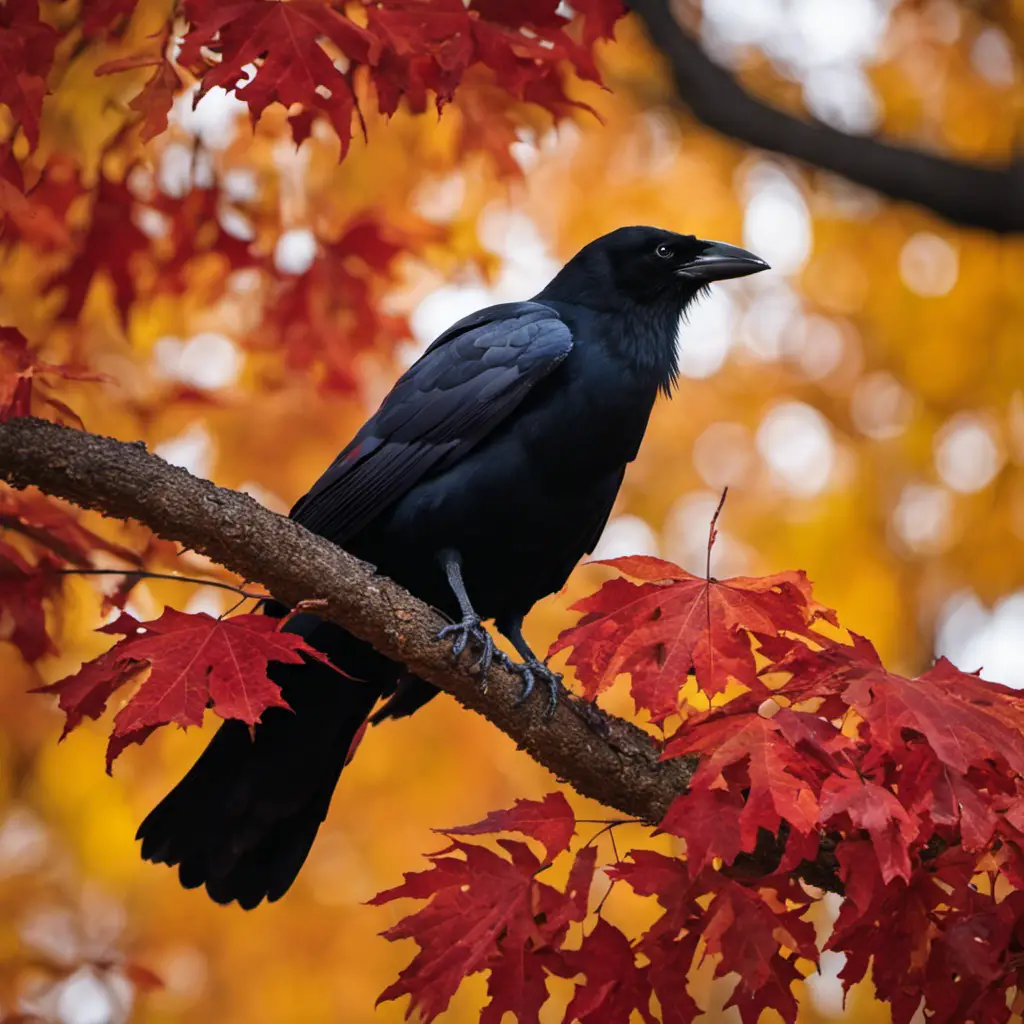
Listen to the loud caw of the American crow as it perches on a tree branch.
The American crow, scientifically known as Corvus brachyrhynchos, is a common bird species found throughout North America, including Minnesota.
Known for its distinctive black plumage, the American crow exhibits fascinating behavioral patterns and has unique habitat and nesting habits.
These birds are highly social and often form large groups called murders, which collaboratively forage for food and defend territories.
They’re highly adaptable and can be found in a variety of habitats, including forests, urban areas, and agricultural fields.
When it comes to nesting, American crows construct large, bulky nests made of sticks, lined with softer materials like grass and fur.
They typically nest in tall trees, providing them with a suitable vantage point to observe their surroundings.
Understanding the behavioral patterns, habitat preferences, and nesting habits of the American crow is crucial for conservation efforts and maintaining a healthy ecosystem.
Bald eagle
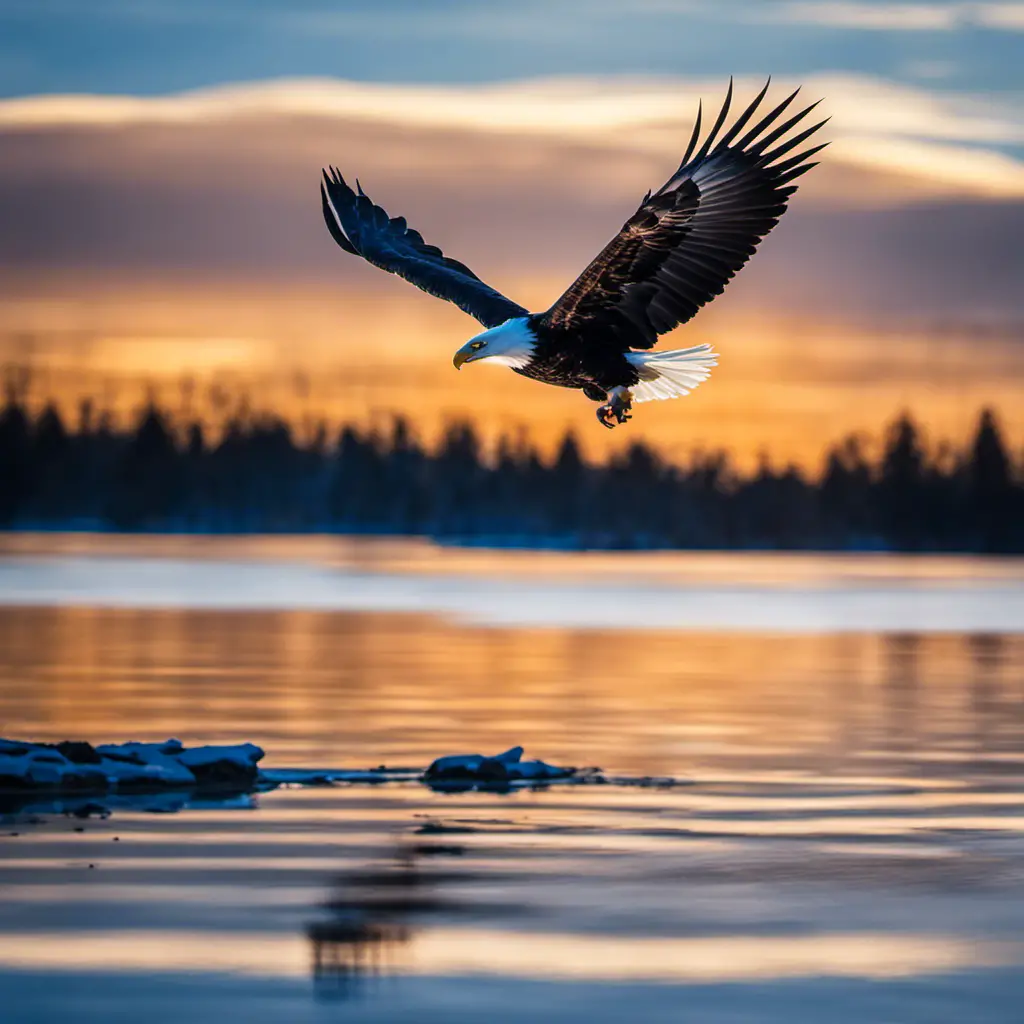
Spotting a majestic bald eagle soaring high in the sky is always a breathtaking sight. The bald eagle (Haliaeetus leucocephalus) is a large bird of prey that’s found primarily in North America. It’s known for its distinctive white head and tail, contrasting with its dark brown body.
The bald eagle isn’t only an iconic symbol of American patriotism but also a fascinating subject of study for scientists. One of the key areas of research is the bald eagle migration patterns. These birds exhibit impressive long-distance migrations, with some individuals traveling thousands of miles each year. Understanding these migration patterns is crucial for their conservation efforts.
Conservationists are working tirelessly to protect the bald eagle population, which was once on the brink of extinction due to habitat loss and pesticide use. Through habitat preservation, legal protection, and public education, conservation efforts have successfully led to a remarkable recovery of the bald eagle population in recent years.
Canada goose
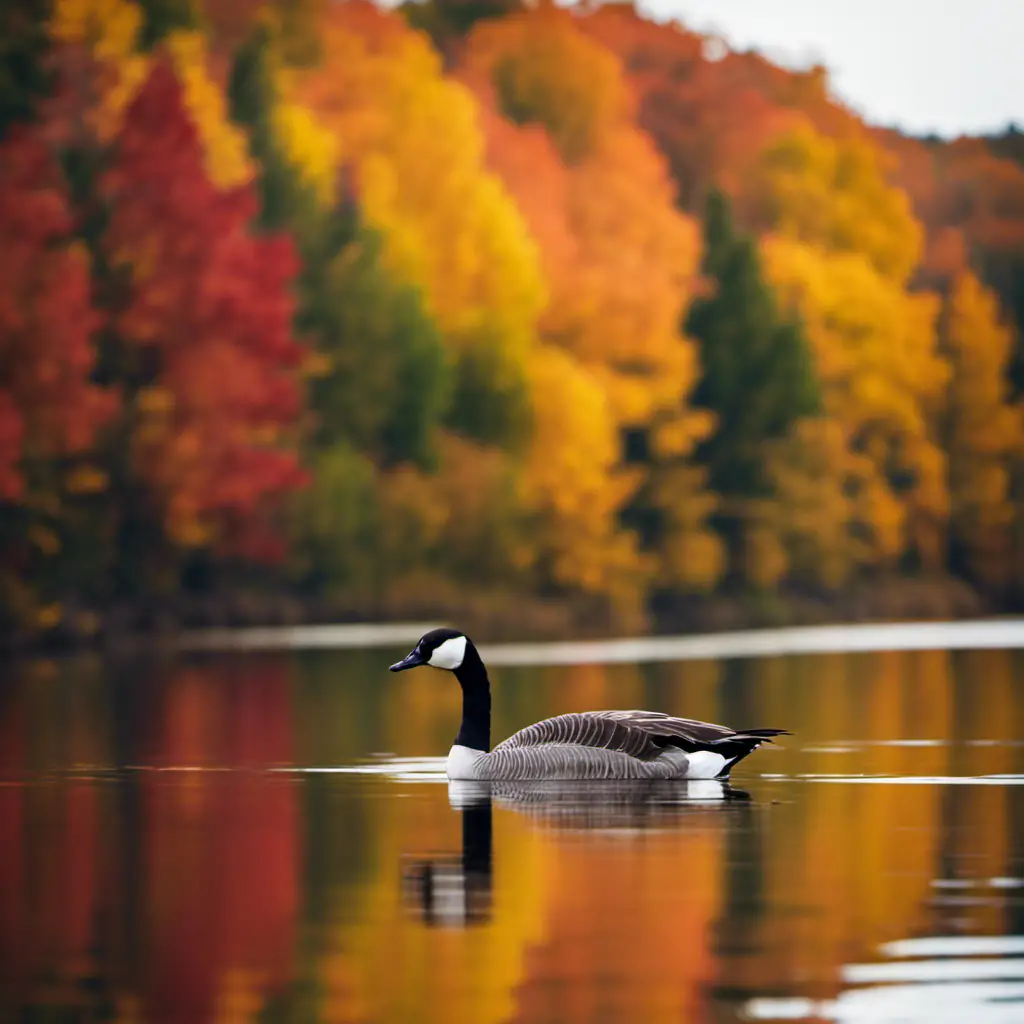
Did you know that the Canada goose is a common sight in Minnesota during the winter months? These majestic birds are known for their distinct black heads, long necks, and signature honking calls. Canada geese are highly adaptable and can be found in a variety of habitats, including lakes, rivers, wetlands, and even urban areas. They prefer areas with abundant food sources, such as grasses, grains, and aquatic plants.
When it comes to migration patterns, Canada geese exhibit remarkable navigational abilities. They follow well-established flyways, which are specific routes that they use during their annual migrations. In Minnesota, these geese migrate from their breeding grounds in the northern regions to spend the winter months in the milder climate of the state. They form large flocks and fly in a distinctive V-formation, taking advantage of the aerodynamic benefits of flying in a group.
It’s truly fascinating to observe these birds as they navigate the vast distances during their migration.
Common loon
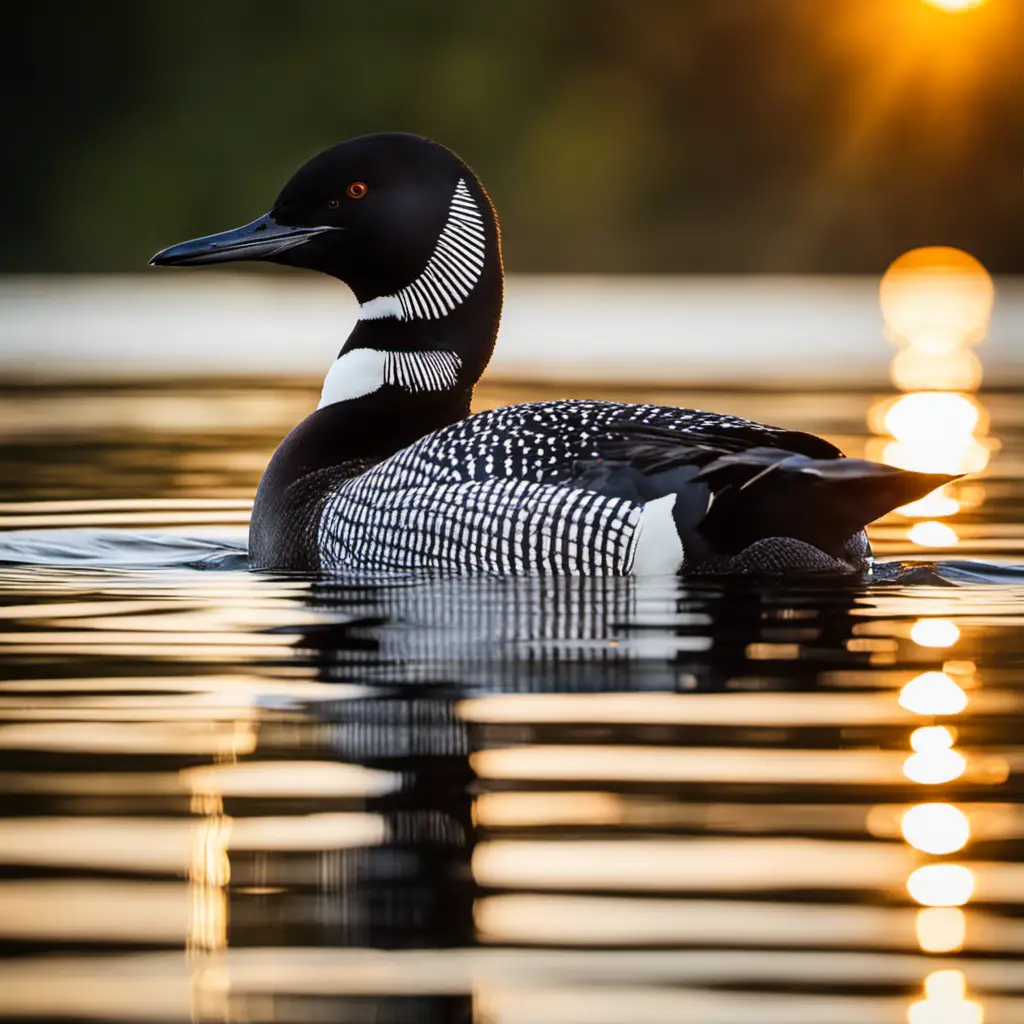
Have you ever seen a common loon diving gracefully into the water searching for fish?
The common loon, or Gavia immer, is a large aquatic bird found in North America. It’s known for its striking black and white plumage, red eyes, and distinctive call.
The loon’s habitat includes freshwater lakes and ponds, where it spends most of its time swimming and diving. It’s a skilled fisherman, using its webbed feet and strong muscles to propel itself underwater.
Conservation efforts are being made to protect the loon’s habitat and behavior. This includes monitoring water quality, creating protected areas, and raising awareness about the importance of preserving the loon’s natural environment.
Common snipe
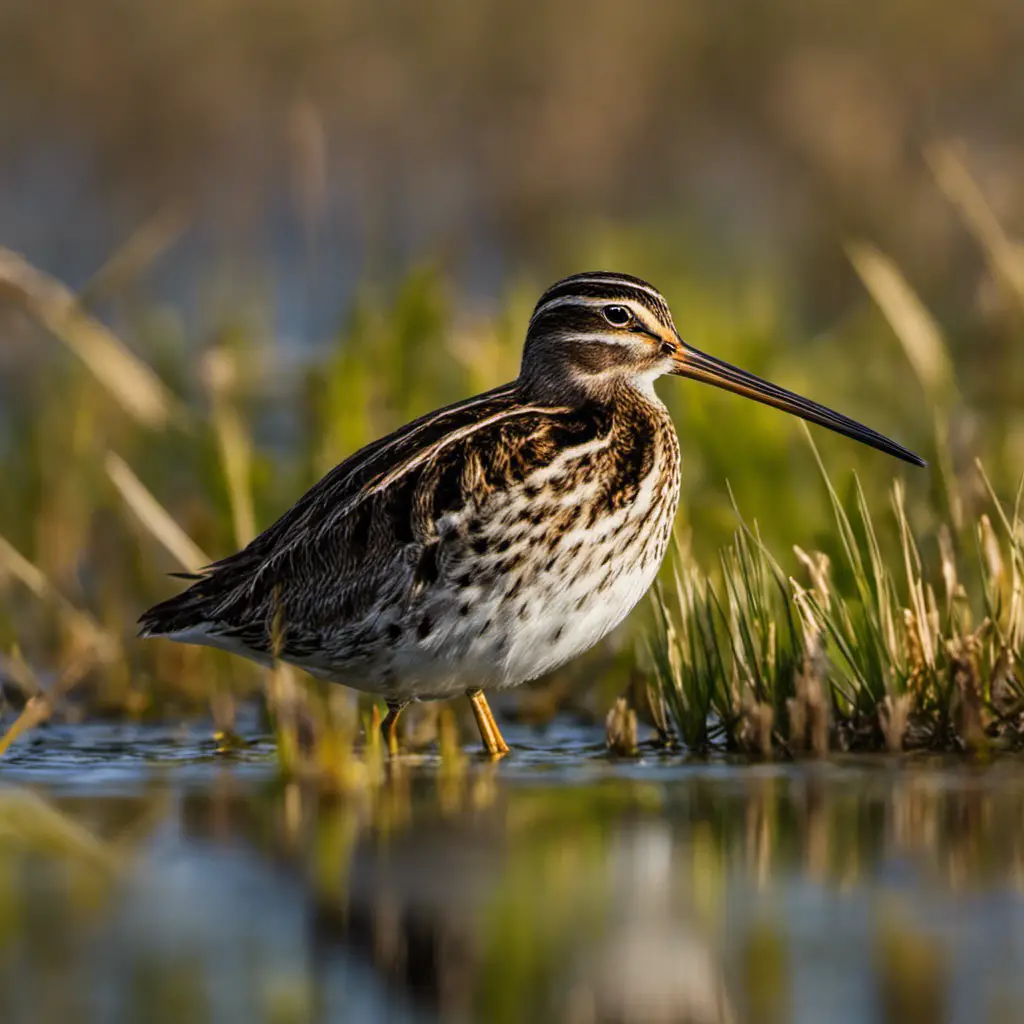
You should definitely keep an eye out for any common snipe or other interesting bird species while exploring the wetlands of Minnesota. The common snipe (Gallinago gallinago) is a migratory bird that can be found in various habitats throughout the state. These birds have distinct behavioral patterns and habitat preferences that make them fascinating to observe.
Here are some key points to consider:
Behavioral patterns:
Common snipes are known for their unique courtship displays, which involve elaborate flights and vocalizations.
They’ve a secretive nature and are often difficult to spot due to their excellent camouflage.
These birds are skilled at foraging in muddy or marshy areas, using their long bills to probe for invertebrates.
Habitat preferences:
Common snipes prefer wetlands such as bogs, marshes, and swamps.
They’re often found in areas with dense vegetation, providing them with cover and nesting sites.
These birds require access to shallow water for feeding and breeding purposes.
Double-crested cormorant
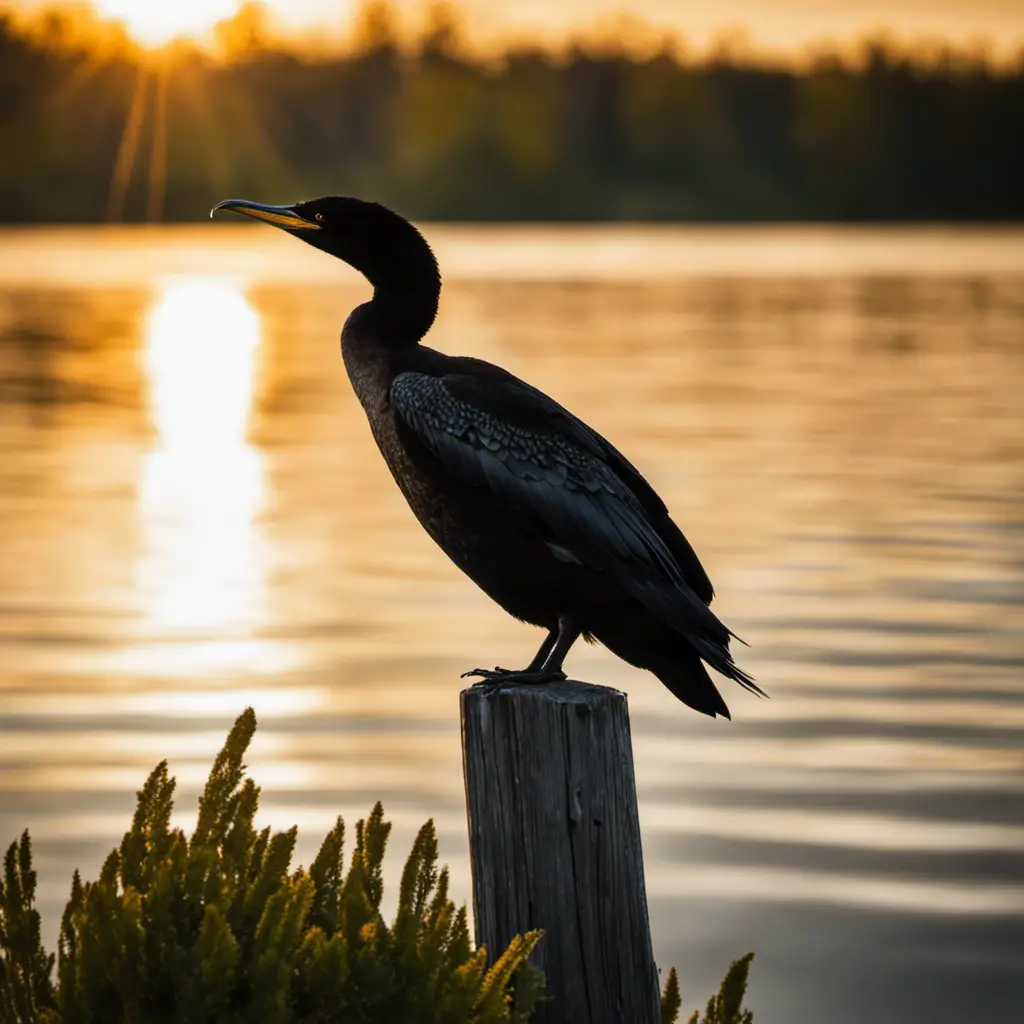
Take a moment to observe the plumage of the double-crested cormorant as it perches on the dock. This bird, scientifically known as Phalacrocorax auritus, is a skilled diver and fisherman, making it an important species to study. Its sleek black feathers provide excellent insulation, allowing it to dive deep underwater for extended periods of time in search of prey.
The double-crested cormorant has a significant impact on the local fishing industry, as it competes with fishermen for fish resources. Its breeding habits are fascinating, with colonies forming in trees or on the ground near water bodies. During migration, these birds travel long distances, sometimes covering thousands of miles.
Understanding the behavior and ecology of double-crested cormorants is essential for conservation efforts and managing their interactions with human activities.
Eastern bluebird
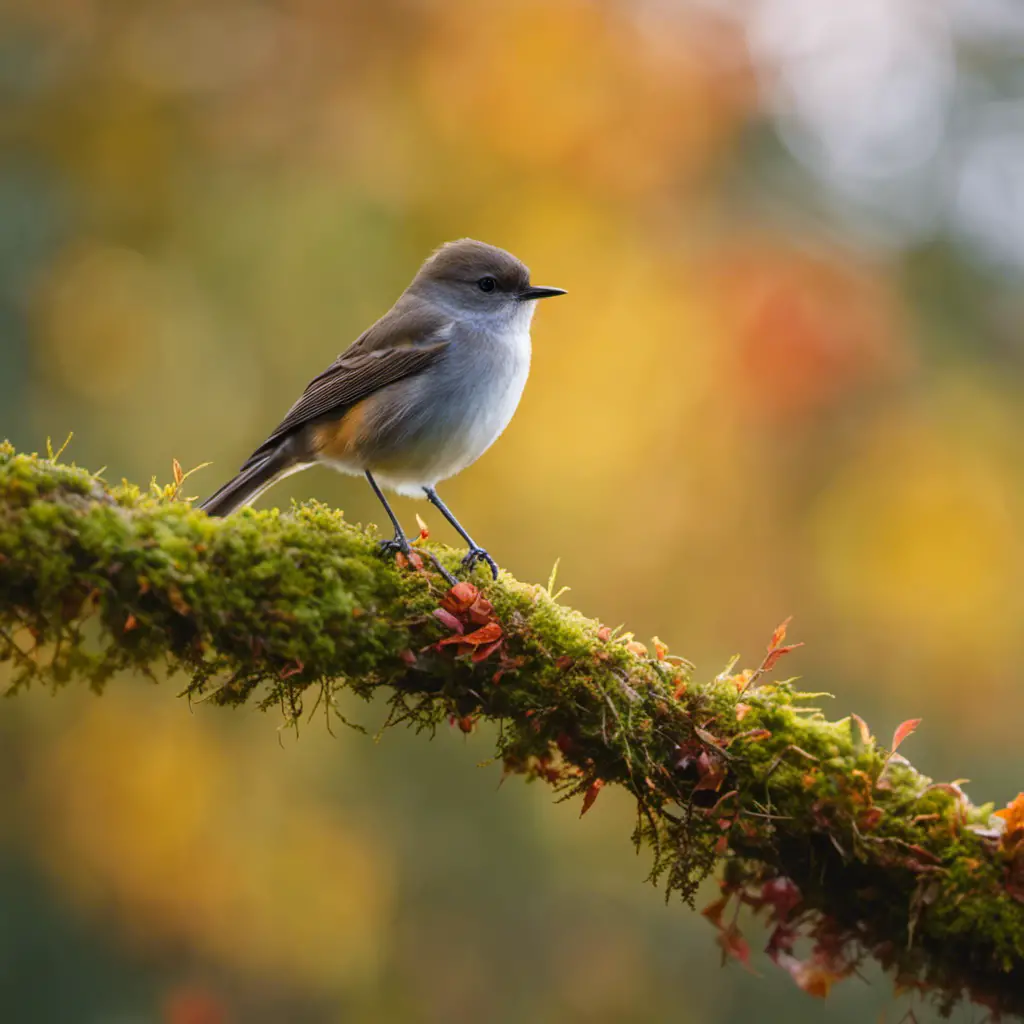
Spotting an Eastern bluebird perched on a branch near you is a rare and beautiful sight. These small, vibrant birds are native to North America and are commonly found in open woodlands, meadows, and farmlands. Eastern bluebirds have specific habitat preferences, as they require open areas with scattered trees for perching and nesting. They prefer areas with short grasses and ample insect populations, which make up the majority of their diet.
Discussion Ideas:
Habitat preferences:
Open woodlands
Meadows
Farmlands
Breeding behavior:
Nesting in tree cavities or nest boxes
Laying 3-7 pale blue eggs
Incubation period of about 12-14 days
Fledglings leave the nest after 15-20 days
Eastern bluebirds are known for their striking blue feathers, rusty red breast, and melodious songs. Their breeding behavior involves nesting in tree cavities or nest boxes, usually in the months of March to August. During this time, the female lays 3-7 pale blue eggs and incubates them for about 12-14 days. Once hatched, the fledglings leave the nest after 15-20 days.
These discussion ideas provide a comprehensive understanding of the Eastern bluebird’s habitat preferences and breeding behavior.
Eastern kingbird
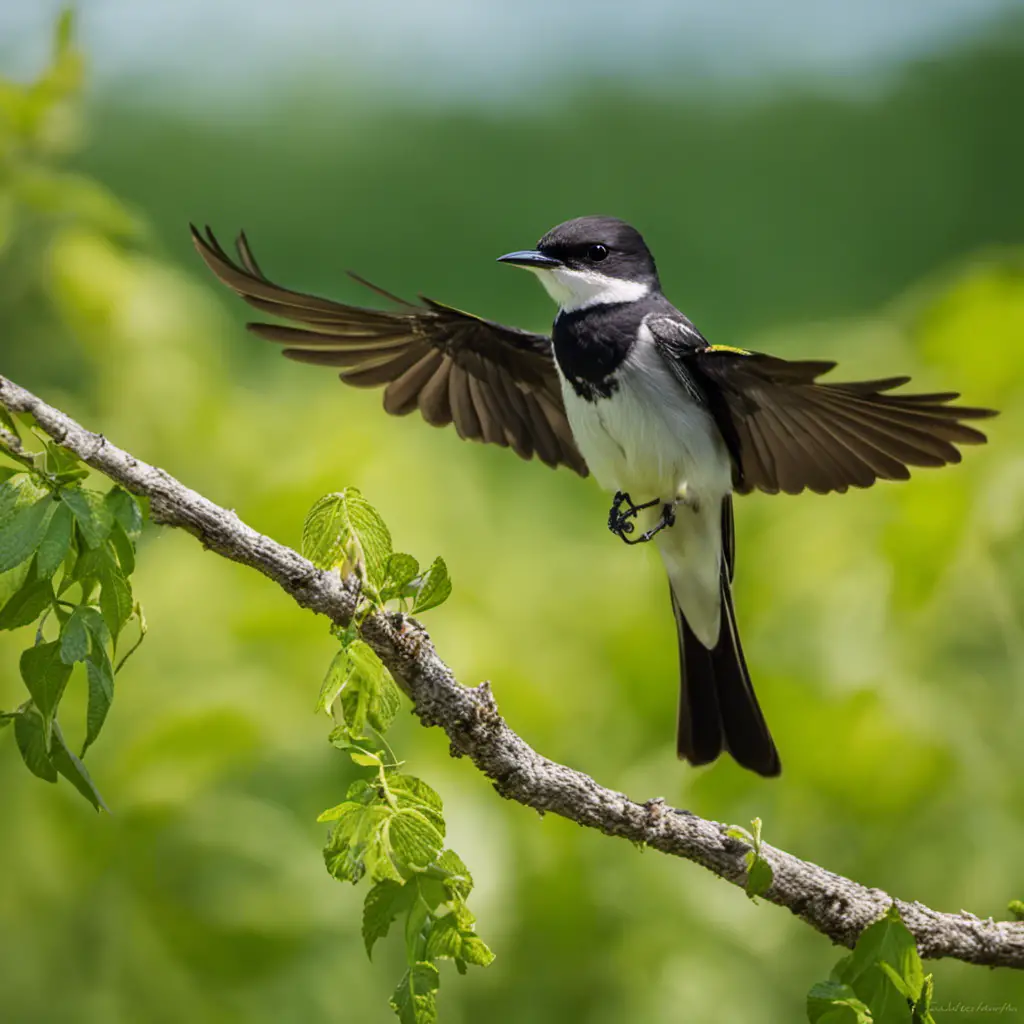
If you look closely, you’ll notice that Eastern kingbirds have a distinct white band on the tip of their tail feathers. These medium-sized birds, belonging to the Tyrannidae family, are known for their blackish upperparts and white underparts.
Eastern kingbirds are commonly found in open woodlands, meadows, and along the edges of forests throughout North America, including their preferred habitat in Minnesota. They’re highly migratory birds, spending their summers in North America and then flying to South America for the winter. Their migration patterns are quite impressive, with some individuals covering distances of up to 8,000 kilometers.
During migration, Eastern kingbirds feed on a variety of insects, including bees, wasps, and dragonflies. Understanding their habitat preferences and migration patterns is crucial for conservation efforts and ensuring the survival of these remarkable birds.
Eastern phoebe

Have you seen an Eastern phoebe, and is it similar in appearance to the Eastern kingbird? While both birds belong to the tyrant flycatcher family, they have distinct differences in appearance.
The Eastern phoebe is smaller, measuring around 6 inches in length, with a dark gray-brown upper body, pale gray underparts, and a white belly. It has a black bill, legs, and feet, and a characteristic white eye-ring. In contrast, the Eastern kingbird is larger, reaching up to 8 inches in length, with a black head, back, and tail, and a white underside.
The Eastern phoebe is known for its unique nesting habits, often building its nest on ledges, eaves, or other man-made structures. It constructs a cup-shaped nest using mud, moss, and grass, lined with feathers and hair.
In terms of diet and feeding behavior, the Eastern phoebe primarily feeds on insects. It’s an adept flycatcher, perching on branches or wires and darting out to catch flying insects mid-air. It also consumes berries and fruits when insects are scarce.
To summarize, although the Eastern phoebe and the Eastern kingbird are similar in their flycatching behavior, they have distinct differences in appearance, nesting habits, and diet.
Great blue heron
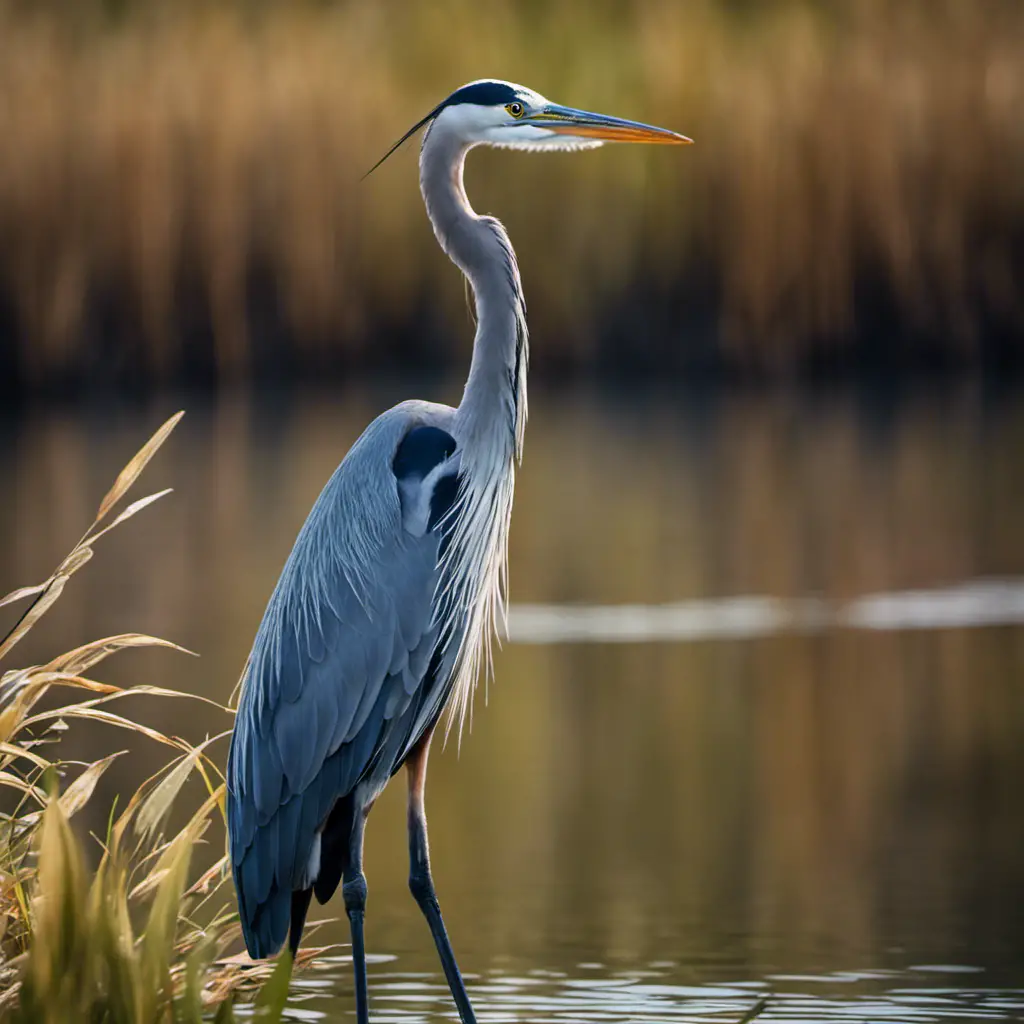
You can often spot a Great blue heron standing motionless in the water, patiently waiting for its next meal to swim by. This majestic bird, with its long legs and neck, is known for its unique hunting strategy.
The Great blue heron is commonly found in wetland habitats across North America, including Minnesota. As a migratory bird, it plays an important role in maintaining the balance of ecosystems. Understanding the bird migration patterns is crucial for their conservation.
Efforts have been made to protect and restore wetland habitats, as they provide essential feeding and nesting grounds for the Great blue heron. By conserving these habitats, we can ensure the survival of this remarkable species and maintain the biodiversity of our environment.
Great horned owl
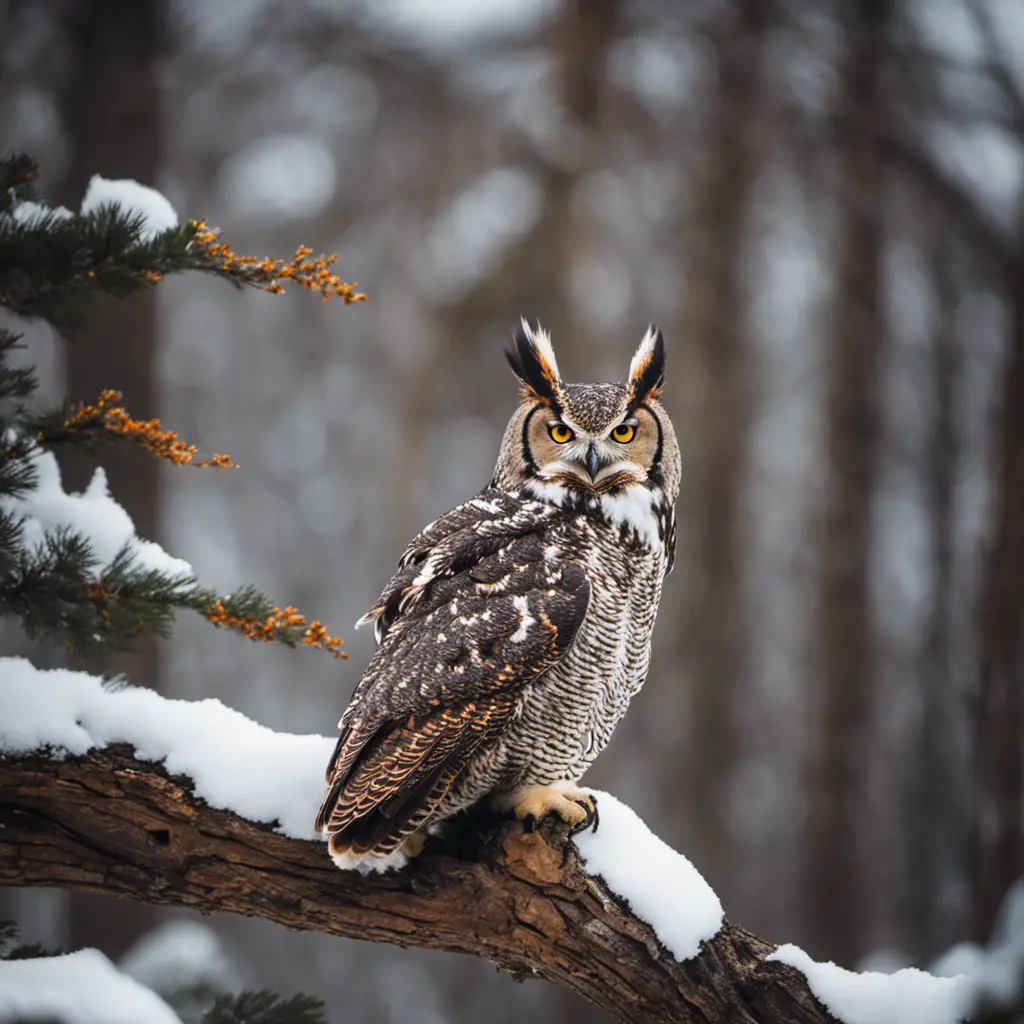
Surely, you can marvel at the majestic Great horned owl as it silently glides through the night, hunting for its prey. This magnificent creature, known scientifically as Bubo virginianus, is a master of the nocturnal realm.
Here are some key discussion ideas to explore its habitat preferences and breeding behavior:
Habitat preferences:
Great horned owls are incredibly adaptable and can be found in diverse habitats, including forests, deserts, grasslands, and even urban areas.
They typically nest in large trees, such as conifers or deciduous trees, which provide protection and camouflage.
These owls often select nesting sites near open areas, such as fields or meadows, where they can hunt for prey more easily.
They’ve a wide distribution throughout North and South America, as well as parts of the Caribbean, showcasing their ability to thrive in various environments.
Breeding behavior:
Great horned owls are monogamous and form long-term pair bonds.
Breeding season typically occurs during early winter to early spring, depending on the region.
They construct their nests or use abandoned nests of other birds, such as hawks or crows.
The female lays 1 to 4 eggs, which she incubates for about a month. Both parents participate in incubation and raising the young.
Understanding the habitat preferences and breeding behavior of the Great horned owl is crucial for conservation efforts and appreciating the wonders of this remarkable species.
Hairy woodpecker
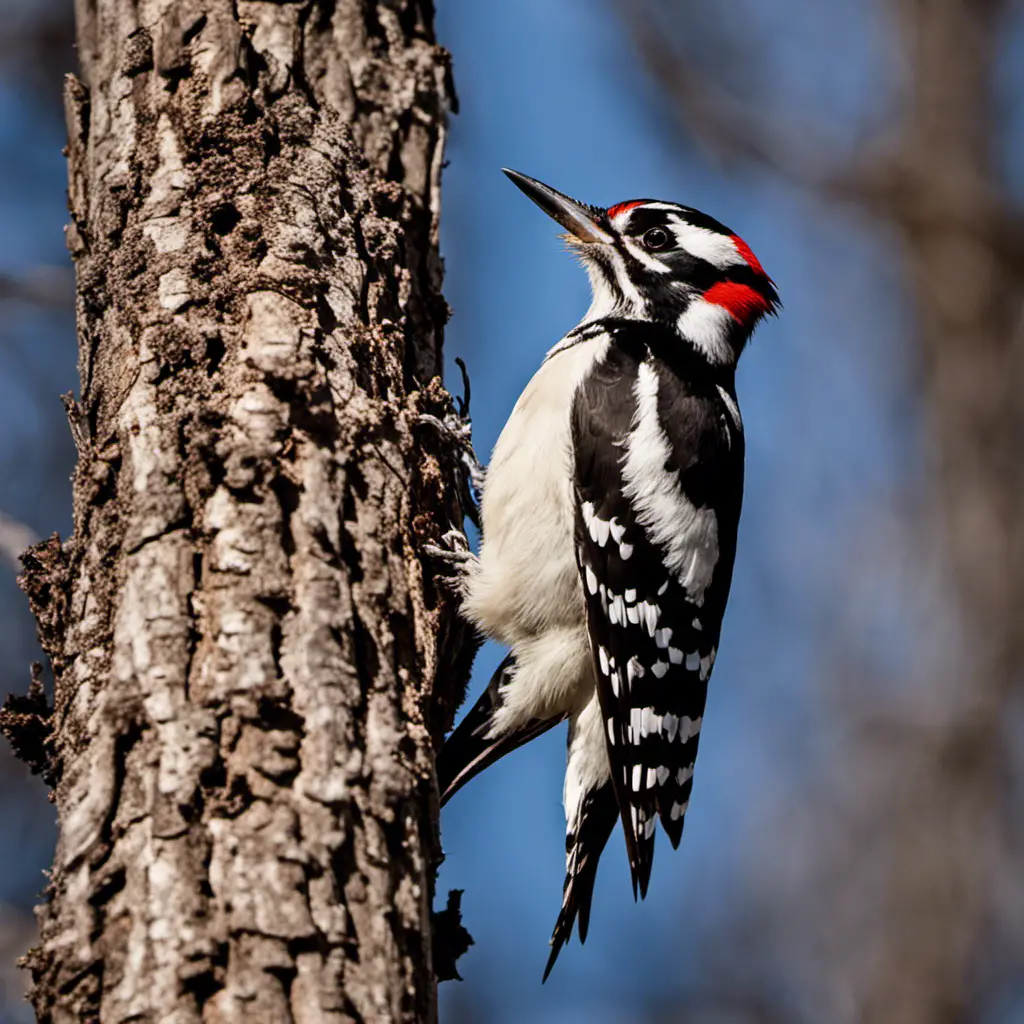
When observing the Hairy woodpecker, be sure to look for its distinctive black and white plumage. This small to medium-sized bird belongs to the woodpecker family and is commonly found in North America.
The Hairy woodpecker is known for its behavioral patterns, particularly its drumming on trees to establish territories and attract mates. It has a specialized bill that enables it to chisel into bark and extract insects, which form a significant part of its diet. In addition to insects, the Hairy woodpecker also consumes seeds, nuts, and fruits.
Its habitat includes deciduous and mixed forests, where it can find suitable tree trunks for foraging and nesting. By understanding the behavioral patterns, habitat, and diet of the Hairy woodpecker, observers can appreciate the unique adaptations and ecological role of this fascinating bird.
House finch
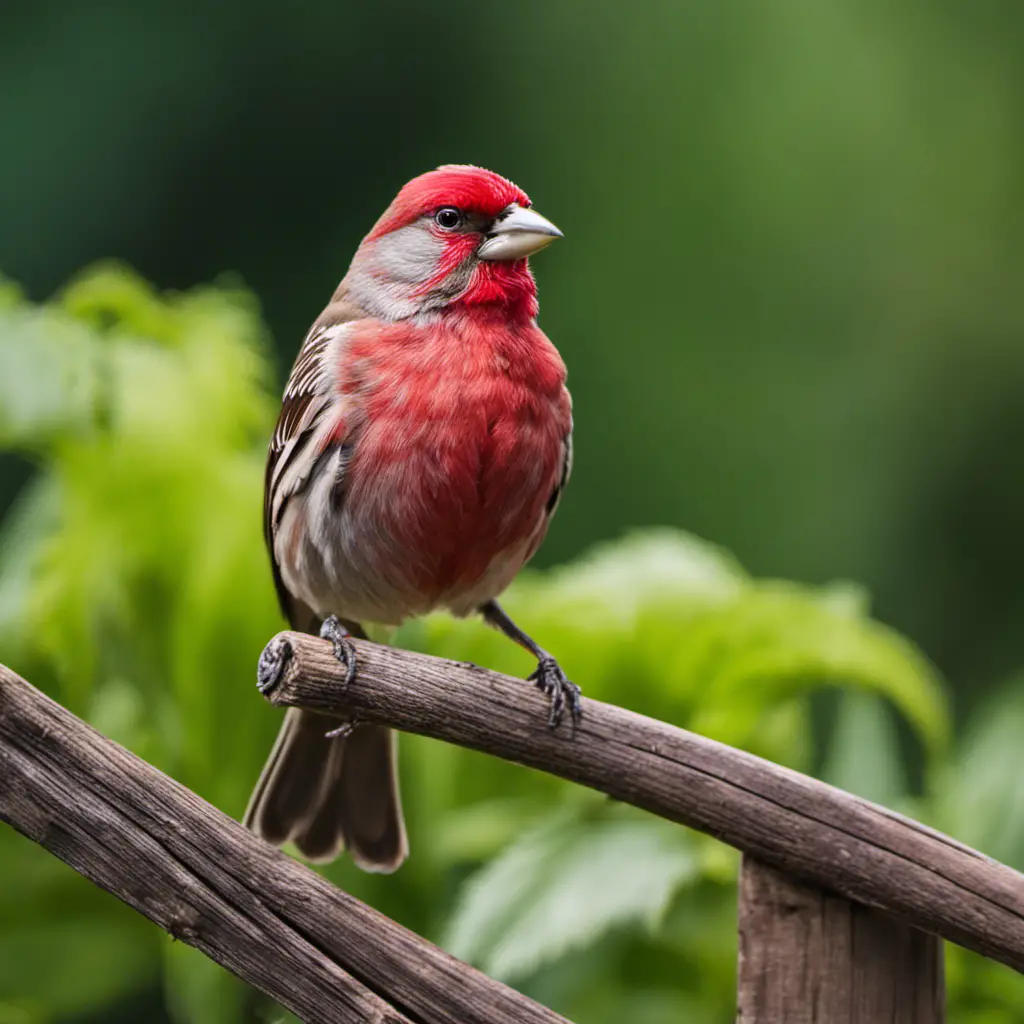
Take a moment to admire the vibrant red plumage of the male House finch, as it adds a splash of color to your backyard. These small songbirds, scientifically known as Haemorhous mexicanus, are commonly found in North America, particularly in urban and suburban areas. House finches are known for their behavioral patterns and habitat preferences, which contribute to their survival and successful breeding.
Here are some key points to consider:
Behavioral Patterns:
House finches are social birds that often form small flocks.
They’ve a melodious song that consists of a rapid, warbling trill.
Males engage in courtship displays, puffing up their feathers and singing to attract females.
They’re opportunistic feeders, consuming a variety of seeds, fruits, and insects.
Habitat Preferences:
House finches are adaptable and can be found in a range of habitats, including forests, deserts, and urban areas.
They’re particularly attracted to areas with abundant food sources and shrubs for nesting.
House finches often build their nests in trees, shrubs, and even man-made structures like hanging baskets or eaves.
Understanding the behavioral patterns and habitat preferences of House finches can help create suitable environments for these beautiful birds in our backyards and communities.
House sparrow
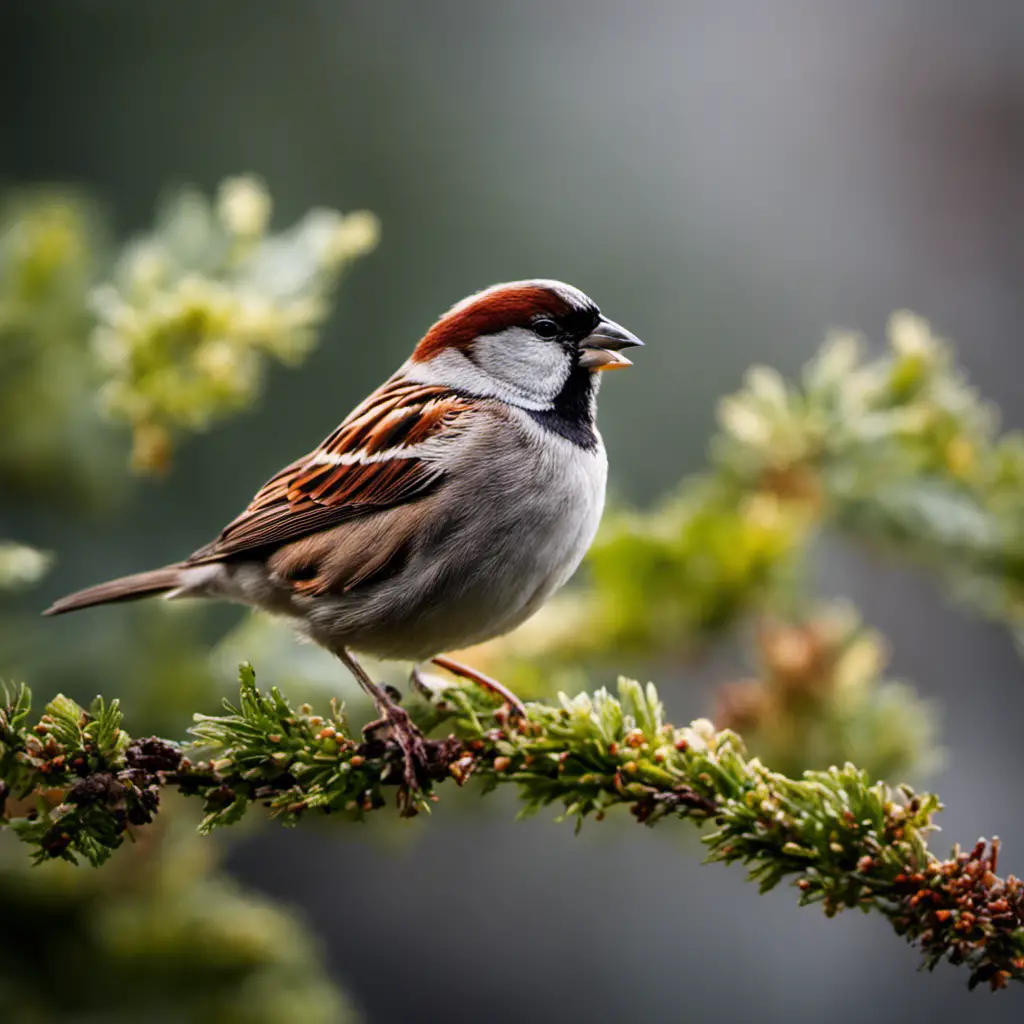
You can easily spot the House sparrow at your bird feeder, for they are known to be frequent visitors. These small birds, with their distinctive brown and gray plumage, are a common sight in urban and suburban areas across North America, including Minnesota. House sparrows are highly adaptable and can thrive in a variety of habitats, from cities to farmland. They are social birds and often travel in flocks, making them a lively presence in any backyard. House sparrows have a diverse diet, feeding on seeds, grains, insects, and even scraps of human food. Their behavioral patterns include aggressive territorial defense, loud chirping, and nest-building in cavities. Here is a table summarizing the behavioral patterns and habitat preferences of the House sparrow:
| Behavioral Patterns | Habitat Preferences |
|---|---|
| Aggressive territorial defense | Urban and suburban areas |
| Loud chirping | Farmland |
| Nest-building in cavities | Cities |
Understanding the behavioral patterns and habitat preferences of the House sparrow can help us appreciate and support their presence in our environment.
Mallard
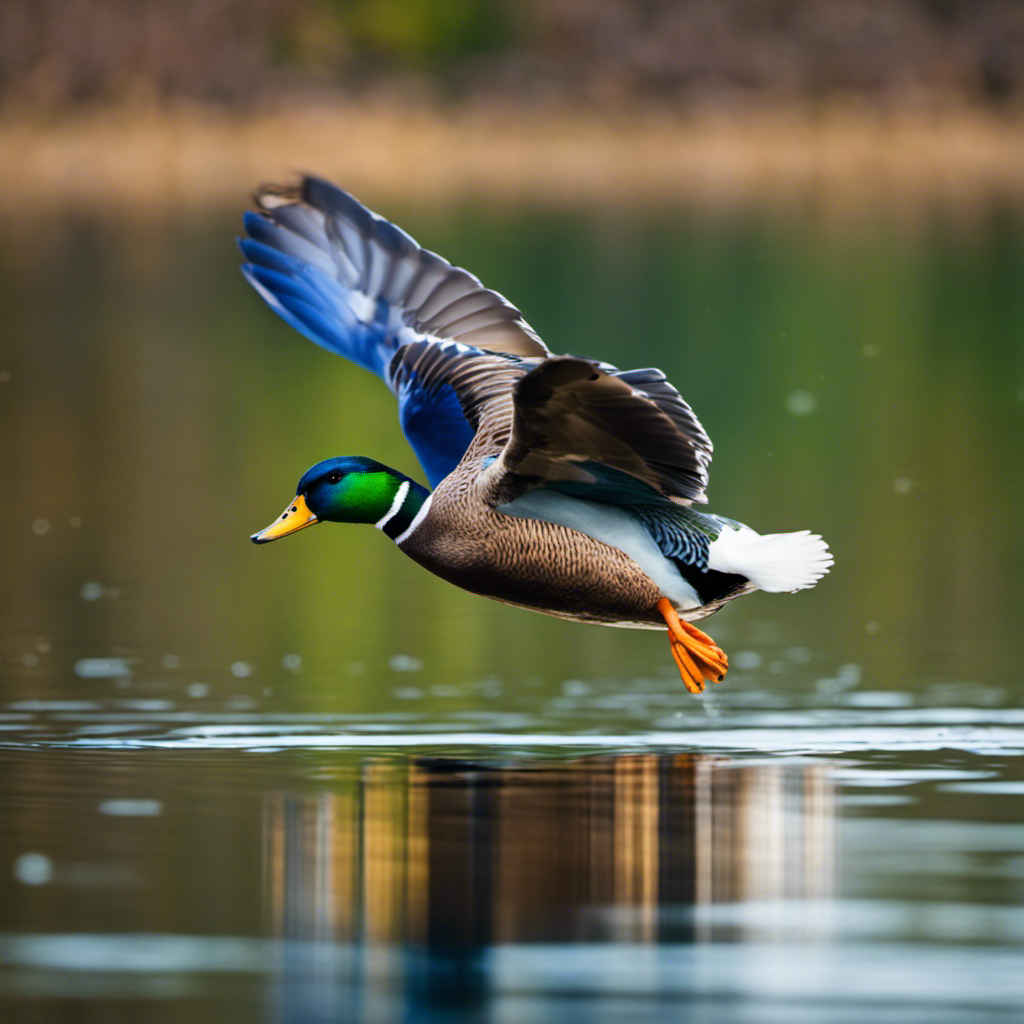
The Mallard is a common duck species found in Minnesota’s wetlands, lakes, and ponds, and it’s known for its vibrant plumage and graceful swimming. This beautiful bird has a wide range of habitats and behaviors that contribute to its adaptability and survival.
Mallard Habitat:
Wetlands: Mallards are commonly found in wetlands with abundant vegetation and water sources.
Lakes: They’re frequently seen in lakes, especially those with marshy areas and shallow waters.
Ponds: Mallards make use of ponds that offer food resources and suitable nesting sites.
Riparian Areas: These ducks are often found in areas along rivers and streams, where they can find both water and vegetation.
Mallard Behavior:
Grazing: Mallards are omnivorous, feeding on aquatic plants, seeds, insects, and small invertebrates.
Nesting: They build nests on the ground, usually near water bodies, using grasses and other plant materials.
Courtship Displays: Male Mallards perform elaborate displays to attract females, including head bobbing and tail wagging.
Migratory Patterns: Mallards have a tendency to migrate during the autumn and return to breed in the spring.
Understanding the mallard’s habitat preferences and behaviors allows us to appreciate and protect these remarkable ducks in Minnesota’s natural ecosystems.
Mourning dove
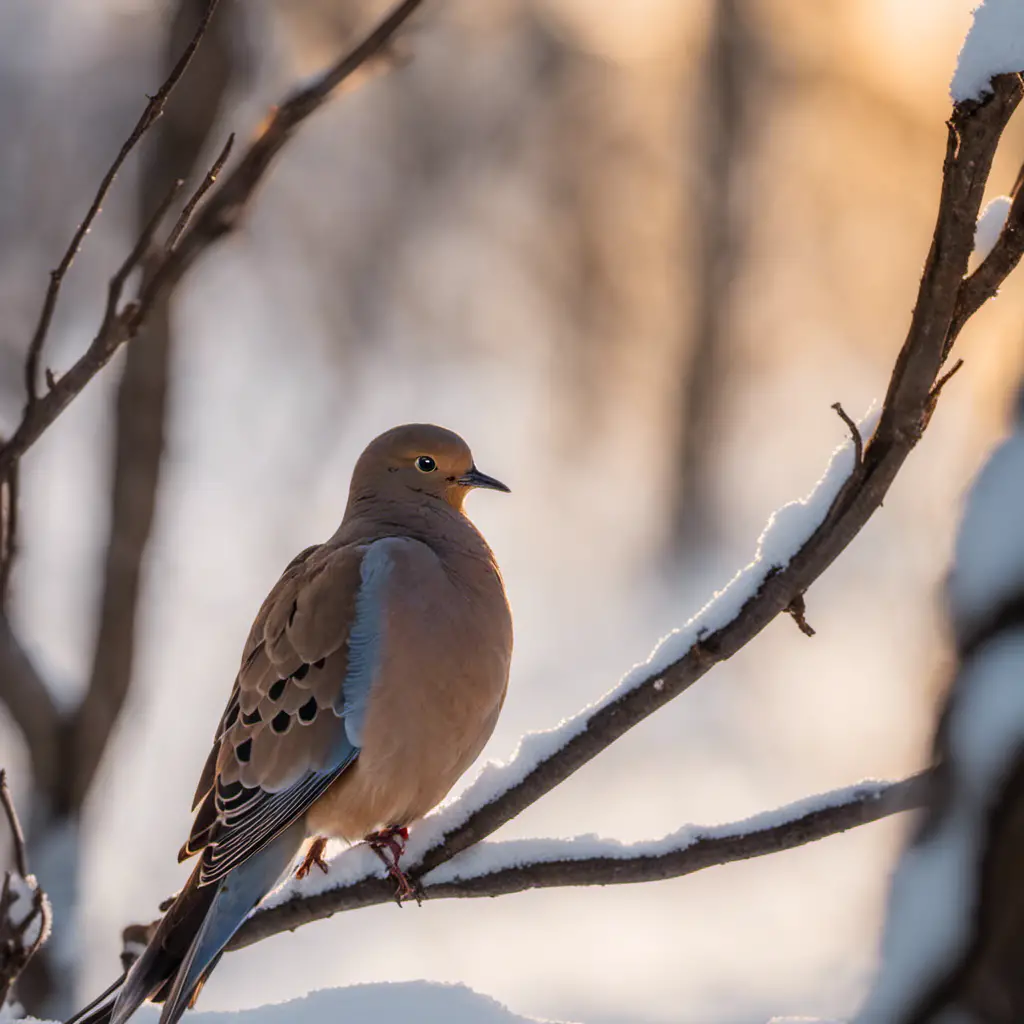
Have you ever noticed how the mournful cooing of a mourning dove can create a soothing atmosphere in your backyard? These gentle birds, known scientifically as Zenaida macroura, are commonly found in North America, including Minnesota.
Mourning doves exhibit fascinating behavior patterns and have distinct habitat preferences. These birds are known for their soft, mournful calls, which are often heard during their courtship displays. They’ve a unique flight pattern characterized by quick, darting movements, followed by a whistling sound as they take off.
Mourning doves prefer habitats that provide open spaces with scattered trees and shrubs, such as grasslands, agricultural fields, and suburban areas. They’re ground foragers, primarily feeding on seeds and grains.
Understanding their behavior patterns and habitat preferences allows us to appreciate the beauty and tranquility these birds bring to our surroundings.
Northern cardinal
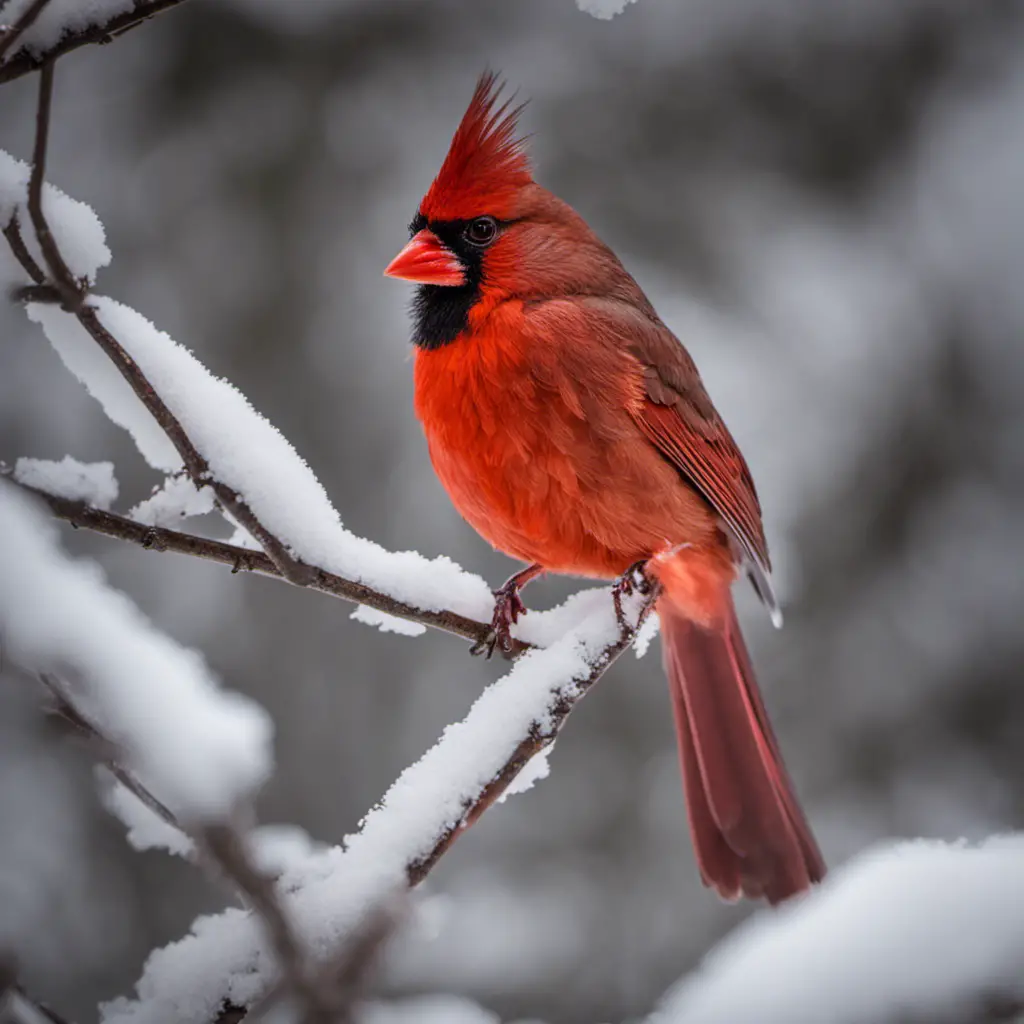
Did you know that the Northern cardinal, with its vibrant red plumage, is one of the most iconic birds in Minnesota? This beautiful bird is known for its distinctive crest and black face mask.
Northern cardinals are commonly found in forests, woodlands, and suburban areas throughout the state. They’ve specific habitat preferences, often choosing areas with dense shrubs and trees for nesting.
Male cardinals are known for their territorial behavior, singing loudly to establish their presence and defend their territory. They’re also known to engage in aggressive behavior towards other males during breeding season.
Female cardinals, on the other hand, have a more subtle appearance, with a reddish-brown color and hints of red on their wings and tail. They’re responsible for building the nest and incubating the eggs.
Overall, the Northern cardinal is a fascinating bird to observe, with its behavior patterns and unique habitat preferences adding to its allure.
Northern flicker
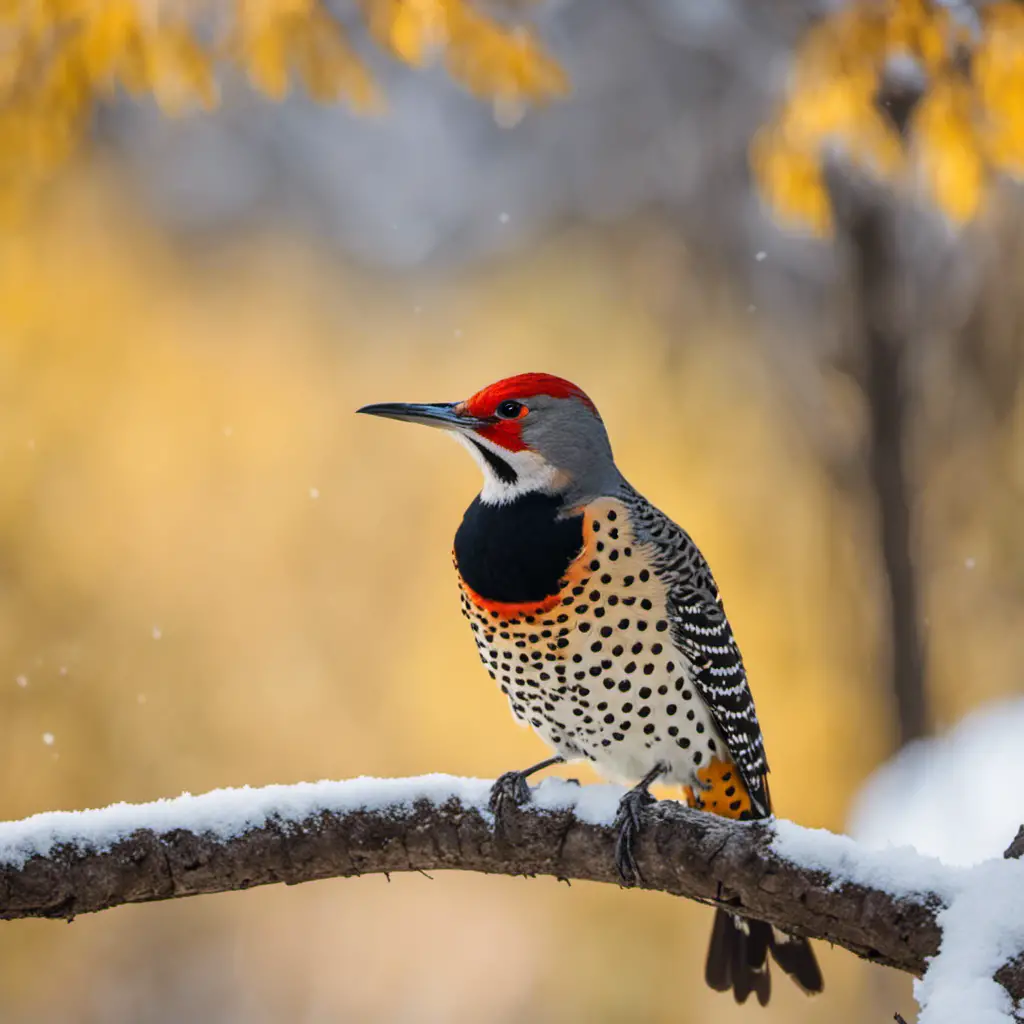
You can easily identify a Northern flicker by its distinct red patch on the back of its head. The Northern flicker is a medium-sized woodpecker found in various habitats across North America, including Minnesota. It has a uniquely patterned plumage, with a brown body covered in black spots and a white rump.
This bird has a unique behavior pattern of using its beak to drum on trees, creating a loud and distinctive sound. It also has a preference for open woodlands, forests, and suburban areas with trees for nesting and foraging.
The Northern flicker is known for its ground-foraging behavior, where it searches for ants and beetles by probing the soil with its long beak. These birds are also known for their migratory habits, with some populations traveling long distances to wintering grounds in the southern United States and Mexico.
Northern mockingbird
But if you want to learn about the Northern mockingbird, it’s a common bird species found in North America. The Northern mockingbird, scientifically known as Mimus polyglottos, is known for its ability to mimic the songs of other birds. This behavior isn’t limited to just bird songs; they can also imitate other sounds they encounter in their environment, such as car alarms or barking dogs.
Mockingbirds are highly territorial and will vigorously defend their preferred habitats, which include both urban and rural areas. They’re most commonly found in shrubs, trees, and open spaces, where they can easily spot potential threats or sources of food.
Their behavior patterns include hopping and flying short distances, as well as engaging in aerial displays to attract mates. Overall, the Northern mockingbird is a fascinating species known for its mimicry skills and adaptable habitat preferences.
Osprey
So, if you’re interested in birds, the Osprey is a remarkable raptor that’s often found near bodies of water. Ospreys are known for their unique migration patterns and nesting habits.
These birds have a strong instinct to migrate, and they travel long distances between their breeding and wintering grounds. Ospreys from North America follow two main migration routes: the Atlantic flyway and the Pacific flyway. Along these routes, they rely on thermal updrafts and favorable winds to assist their journey.
When it comes to nesting, Ospreys build large stick nests, typically on tall structures such as trees, cliffs, or man-made platforms. These nests are often reused from year to year and can become quite massive.
Ospreys are fascinating creatures that demonstrate remarkable adaptability and resourcefulness in their migration and nesting behaviors.
Red-bellied woodpecker
If you’re looking for a unique bird to observe, take a closer look at the Red-bellied woodpecker, as it’s known for its distinctive red belly and its ability to drum on trees with its powerful beak. This fascinating bird has several behavioral adaptations and specific habitat preferences that contribute to its survival and success.
Behavioral adaptations:
The Red-bellied woodpecker has a specialized tongue that can extend up to 2 inches beyond its beak. This allows it to reach deep into crevices to extract insects and larvae.
It can cling to vertical surfaces due to its strong feet and stiff tail feathers, enabling it to navigate tree trunks effortlessly.
This woodpecker has a unique drumming behavior, using its beak to create loud and distinctive sounds. This serves both as a territorial display and a means of communication.
Habitat preferences:
The Red-bellied woodpecker is commonly found in mature forests with a mix of deciduous and coniferous trees.
It prefers wooded areas with standing dead trees or snags, which provide nesting sites and a reliable source of insects.
This species is adaptable and can also be found in suburban areas with large trees and sufficient food sources.
It typically avoids dense forests and open grasslands, instead favoring more diverse habitats.
Observing the Red-bellied woodpecker in its natural habitat provides a captivating experience, showcasing its remarkable behavioral adaptations and distinct habitat preferences.
Red-tailed hawk
You can easily spot the majestic Red-tailed hawk soaring gracefully through the sky, as its broad wingspan and keen eyesight make it a formidable predator. With its distinctive red tail and brown plumage, this hawk is a common sight in North America, including Minnesota. The Red-tailed hawk exhibits interesting behavioral patterns and displays specific habitat preferences. To understand these aspects, let’s explore the table below:
| Behavioral Patterns | Habitat Preferences |
|---|---|
| Solitary hunters | Open areas |
| Migratory species | Forest edges |
| Monogamous breeding | Grasslands |
Red-tailed hawks are solitary hunters, often perching on high vantage points before swooping down to capture their prey. They migrate seasonally, with some individuals staying in Minnesota year-round. They are monogamous breeders, forming long-term pairs. In terms of habitat preferences, Red-tailed hawks favor open areas such as grasslands and forest edges, which provide them with ample hunting opportunities and suitable nesting sites. By understanding their behavioral patterns and habitat preferences, we can better appreciate and protect the Red-tailed hawk population in Minnesota.
Ring-billed gull
You can often find the Ring-billed gull near bodies of water, as it’s a common sight along the coastlines and lakeshores of Minnesota. This medium-sized gull, with a body length of 17-21 inches and a wingspan of 44-49 inches, displays interesting behavioral patterns and specific habitat preferences.
Behavioral patterns:
Ring-billed gulls are highly social birds, often seen in large flocks.
They’re opportunistic feeders, scavenging for food in diverse habitats.
These gulls are known for their aggressive behavior during the breeding season, defending their nesting territories.
They’ve a distinctive call, a high-pitched ‘kak-kak-kak’ sound, often heard when in flight or during social interactions.
Habitat preferences:
Ring-billed gulls primarily inhabit coastal areas, including ocean shores, estuaries, and bays.
They also frequent inland lakes, rivers, and reservoirs, especially during the breeding season.
These gulls prefer open areas with easy access to nesting sites and ample food sources, such as beaches, islands, and marshes.
They’re adaptable birds and can be found in urban areas, foraging in parking lots and garbage dumps.
Rock pigeon
Take a closer look at the rock pigeon, as it can be found in various urban and rural areas across Minnesota. The rock pigeon, scientifically known as Columba livia, is a common bird species that exhibits several behavioral adaptations to survive in its environment.
These pigeons have adapted well to human settlements and can often be seen perched on buildings, bridges, and other man-made structures. They’ve a distinctive cooing call and are known for their ability to fly swiftly and maneuver in tight spaces.
In terms of habitat and nesting preferences, rock pigeons typically build their nests in crevices and ledges, using materials such as twigs and grass. They’ve also adapted to urban environments by utilizing buildings and rooftops as ideal nesting sites.
Overall, the rock pigeon’s behavioral adaptations and habitat choices have allowed them to thrive in both urban and rural areas of Minnesota.
Ruby-throated hummingbird
If you want to attract Ruby-throated hummingbirds to your garden, make sure to provide a variety of nectar-producing flowers and a reliable source of fresh water. These small, vibrant birds are known for their unique migration patterns and fascinating feeding habits.
Here are some key points to consider:
Nectar-producing flowers: Ruby-throated hummingbirds primarily feed on nectar from flowers. Plant a diverse array of blooming plants such as bee balm, cardinal flower, and trumpet vine to attract these birds to your garden.
Fresh water source: Hummingbirds not only need nectar but also require a constant supply of fresh water. Provide a shallow birdbath or a dripping water feature to meet their hydration needs.
Migration patterns: Ruby-throated hummingbirds embark on incredible journeys, migrating thousands of miles from their wintering grounds in Central America to their breeding grounds in eastern North America. Understanding their migration patterns can help you anticipate their arrival and departure.
Feeding habits: Hummingbirds have a high metabolism and need to consume large amounts of nectar to fuel their energy demands. They feed by hovering near flowers and extending their long, slender beaks into the blooms to extract nectar.
Frequently Asked Questions
What Is the Average Lifespan of a Bald Eagle?
The average lifespan of a bald eagle is around 20 years. They are known for their breeding habits and their population trends have been closely monitored.
How Does the Eastern Bluebird Attract a Mate?
To attract a mate, the eastern bluebird engages in courtship behaviors. These behaviors include singing melodious songs, displaying vibrant plumage, and offering potential nesting sites. Through these actions, the bluebird increases its chances of finding a suitable partner.
What Is the Preferred Diet of the Common Loon?
The preferred diet of the common loon consists mainly of fish, such as perch, pike, and trout. Their feeding habits involve diving underwater to catch their prey, using their sharp beaks and agile bodies to swiftly capture their meal.
How Far Can the Northern Cardinal Migrate During the Winter?
During winter, northern cardinals migrate to escape the harsh conditions. Their migration patterns vary, but they can travel hundreds of miles to reach their wintering grounds. These birds are known for their vibrant plumage and melodic songs.
What Is the Nesting Behavior of the Osprey?
Ospreys are magnificent birds known for their unique nesting behavior. They build large nests made of sticks near bodies of water, such as rivers or lakes. Osprey conservation efforts focus on protecting their nesting sites and ensuring their survival.
Conclusion
In conclusion, Minnesota is home to a diverse range of bird species, each with their own unique characteristics and habitats.
From the graceful flight of the common loon to the majestic presence of the bald eagle, these birds provide a captivating display of nature’s beauty.
The state’s wetlands attract species such as the American coot and Canada goose, while the urban areas are frequented by the American crow and rock pigeon.
Overall, the birdlife in Minnesota offers a remarkable glimpse into the rich biodiversity of the region.

An avid ornithologist, zoologist and biologist with an unwavering passion for birds and wild animals.
Dr. Wilson’s journey in ornithology began in childhood and led him to obtain a Ph.D. in Ornithology from the prestigious Avian Research Institute. He has worked closely with renowned experts in the field and conducted extensive research and field studies globally.

